In the FAQ you can learn everything about tegolySIGN and digital signatures.
No, neither now nor in the future. The recipient is informed about the signature request by e-mail and only has to open the document and sign it. Recipients do not have to pay anything and do not need any special training. Signing works quite quickly and easily. Afterwards, both you and the recipient will receive a copy of the document.
With a 14-day trial subscription, you can fully test the app and discover the benefits of electronic signatures. If you decide not to continue the trial subscription within the 14-day period, we will not charge you.
Of course! We ensure compliance with strict US and EU electronic signature laws, use security mechanisms similar to those used in banks, provide two ways to authenticate the signer’s identity, and each transaction includes a comprehensive, court-approved audit trail. For more information, please see our Terms of Use.
The decision is up to you: The monthly subscriptions are only extended by one month at a time. With an annual subscription, you pay an annual fee and commit yourself for the next 12 months – but with a discount.
In the free trial version, the number of documents is limited to 10 and the number of users to 5. By starting a regular subscription, you can then add as many users and sign documents as you want.
Yes. Every signature made via our app meets the relevant security standards and is legally binding proof of contract.
Senders are persons who upload, sign and send documents via tegolySIGN or request signatures from other persons via tegolySIGN.
Someone who receives a signature request and responds to it is not considered the sender. Such users do not need a tegolySIGN account to sign documents and the process is free of charge for them.
You can choose – during or at the end of the free trial period – the subscription you want and the number of users. You will receive the invoice when the trial period has expired.
You can pay by credit card payments via the app or in the MS Store. Contact our team if you prefer another payment method.
Monthly subscriptions are billed on a monthly basis. For annual subscriptions you pay an annual fee in advance.
Yes, your subscription will be renewed automatically – unless you change or cancel your subscription. You can do this within seconds via the account settings.
Then send an email to our support. We are happy to help you!

– be clearly associated with the signatory
– enable the identification of the signatory
– be created by means under the sole control of the signer, such as a phone, tablet, or PC;
– and ensure that the act to which it refers cannot be amended
© 2023 All rights reserved
Made with ❤ in Witten